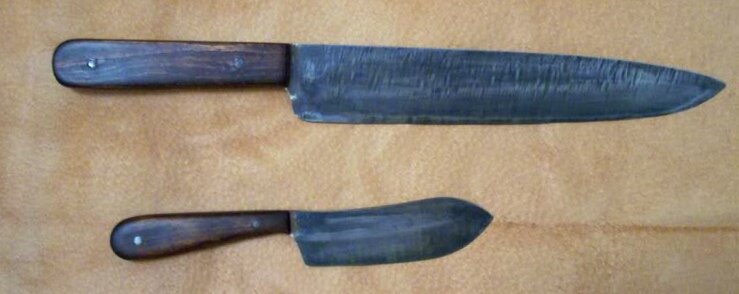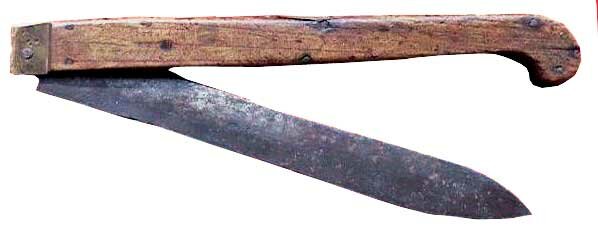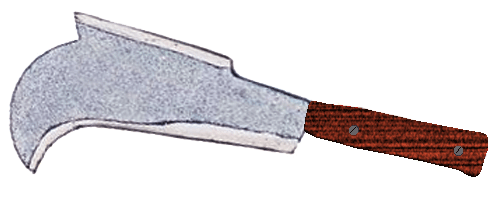
Gully knife
A gully is simply a big knife. It was not usually a fighting knife but could be used as such in a pinch. Some gully's were folding pocket knives but for the most part they were similar to the knife you would find in your kitchen. The folding knives were smaller. In any case, the gully was another tool that was commonplace among sailors and were quite often used in mutinies simply because nothing else could be had. Today, the gully would be replaced by such knives as a Buck knife or Swiss Army pocket knife.
The gully was better suited for hacking than stabbing and typically only one side of the blade contained an edge. (In some instances part of the top side of the blade also has an edge) It had numerous legitimate uses on board a ship, being everything from the sailors eating utensil to his main tool for cutting fouled rigging and such.
Sheath Knife

18th Century Trade knives.
Fixed blade knives were very common aboard ship and were considered a neceissity for survival at sea. The knives were not issued from stores but bought by the sailors themselves. However, the types of knives allowed aboard the ship were often controlled by the ship's captain. A good sailing knife had a single edge and stiff spine that could be pounded on (batoned) with a wooden belaying pin to cut through a heavy tarred line.
There is strong evidence that ship's captains would have the pointy tips of fixed blade knife broken off in order to make the knives less deadly in the event of accidents or intentional attacks. While I have not found official government regulations staitng this as an official Navy policy such actions did occur on board both military on a merchant ships. Sailors may have also done this on their on to prevent accidental stabbings in the rigging.

A sailor's knife with the blunted tip.
Folding Gully

Folding Gully
Typical folding knife used throughout the 17th Century and into the 19th Century. (in this case a simple peasant knife, also called a friction folder.) Folding knives had the advantage of taking up less space and could be carried in a pocket without a sheath. Pocket knives proved popular among sailors and eventually evolved into more elaborate pocket knives containing other utensils, typically a scaling blade, and marlinespike, and still later such items as cork-screws and even tooth picks and screw drivers.
While fixed bladed knives were more practical, especially onboard ships, folding knives were very popular simply because of convenience of carry. Navy regulations from many countries also forbade the carrying of fixed blades or sheath knives among crews and many merchant services also limited their use, thus increasing the popularity of folding pocket knives. By the 19th century, Folding knives designed for ship board use were becoming standardized and by the latter half of the 19th century the folding marlin spike knife was a common sight on sailing vessels.
Billhook
The billhook was is a popular work knife used for everything from cutting vegetation to carvig up meat. Surprisingly, this large knife was considered essential for the the preperation of food and just general chopping. Of course a knife that cleave open a sea trurtle's shell could just as easily split a head. The billhook was part of a soldier's kit and thus soldiers stationed on stips would carry these nasty implements. Pirates would also have such knives aboard ship.

Boucan Knives
Other knives of a more offensive nature were common among sailing vessels in the Caribbean. The most common of these was a "Boucan" knife. The boucan was the knife used by Buccaneers. They came in all sizes and shapes and appear to be nothing more than a cut down cutlass. The knives were originally used when the buccaneers hunted wild pig and oxen on the Islands around Santa Domingo and Jamaica. These knives were still primarily a utility knife but could be used effectively in combat. The were primarily designed to hack or slash an opponent as opposed to stabbing.
Modeled after and/or made from broken cutlasses, the boucan knives were originally long bladed knives used on wild game when hunting. Of course they also made handy self defence weapons. The knives would be used in cutting the animal apart and preparing the meat for smoking or barbecueing (what the native islanders called "boucan"). A cutlass proves unwieldy when cutting apart animals and smaller knives would not have had a strong enough blade to hack through bone and sinew.


The only author and editor of all pages on the site. Most of what I write about is based on years of book reading on the topic. My first web page was published back in 1994.